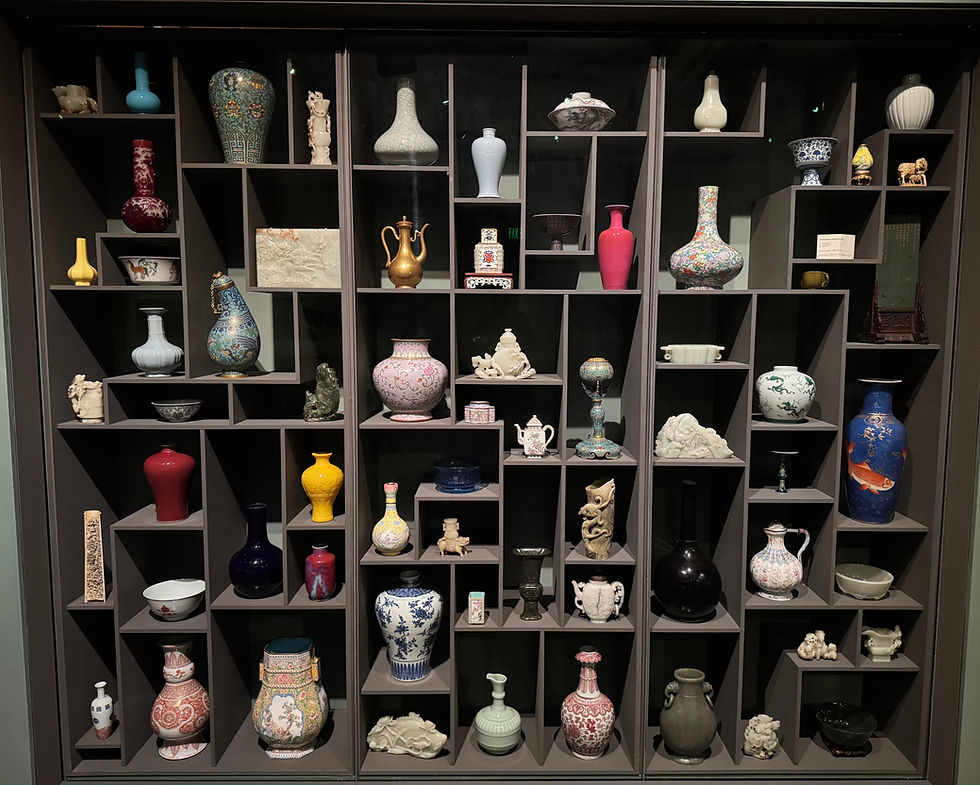A Magnificent Chinese 18th Century Imperial Qianlong Vase Spotted at the Met Museum!
- Anthony Wu

- Aug 20, 2022
- 4 min read
Updated: Feb 20, 2025
Hello again and I can't believe it's August already! By now I hope everyone has had a summer vacation - and for those who haven't, will be going on one soon!
I was just recently in New York City for 1.5 days of Asian art appraisal work and managed to stay an additional three days with relatives on Long Island. It wasn't the longest of breaks, but still refreshing considering the busy Fall season is just around the corner.
In the coming weeks, I'll be going (back) to New York for the Asia Week events in mid September. This will be followed by a trip to Vancouver to finalize my October Asian art online auction at Heffel. And in all likelihood, I will be (back) in London for the Asian art events in November. It's pretty exhausting, but at least in my line of work, I pretty much know where I will be every 6 months!
Anyways, while I was in NYC for those 1.5 days, I was able to quickly visit the Metropolitan Museum of Art to do some quick research on another porcelain project I am working on.
While there, I found that the museum has rotated some of the porcelain wares on the second floor of Florence and Herbert Irving Chinese Art Galleries. What caught my eye was this amazing Chinese porcelain famille rose vase from the Qianlong period (1736-1795), and I really wanted to this object and its details to the readers of my blog.

Image 1. Here is a front view of the vase. The museum describes it as a 'Vase with Peony and Magnolia'.
If you wanted to add a little bit more 'flair' in the title - and make it more on par with a current Christie's or Sotheby's Hong Kong auction catalogue, it can be called 'A Magnificent and Extremely Rare Chinese Famille Rose 'Peony and Magnolia' Hu Vase'.
The emphasis on this vase is really on 'magnificent' and 'rare' as there are so few similar examples of this type of vase in existence. The vase really shows the ingenuity and craftsmanship of Imperial porcelain production during the height of the Qianlong reign.
This vase has excellent provenance since it was donated to the Met by a Benjamin Altman in 1913 (full accession number is 14.40.89). Just by looking at the donation date, you can tell that the vase does have a lot of age, and can barely even pass for Republican Period (1911-1949).
The vase is particularly large at about 40 cm high (I wasn't able to measure this vase as if I was at an auction preview), and the painting was done by a master painter who was an expert with using famille rose. This type of enamelling technology was brought to China by Jesuit priests during the Kangxi reign (1664-1722) of the Qing Dynasty.
Famille rose enamels uses a lot of rose gold in the pigments, thus there is a wider range of colours throughout. It also allowed for more shading, as the enamelling and style of painting during this period was heavily influenced by the European Baroque style. The decoration of this vase is simply gorgeous and really does show off the enamelling technology of 18th Century China.
The form is quite amazing too. It is the shape of a hu which is a vase with a bulbous body that rises to a funnel neck. Porcelain hu vases pay homage to excavated Chinese bronze age examples from the Zhou to Han Dynasties (1050 BC to AD 220), particular favourites of the Qianlong Emperor.

Image 2. Here is a side view of the vase and its unique handles. The handles are in the form of Chinese belt hooks with the appearance of being tied with realistic tromp l'oeil (trick-of-the-eye) flowing red ribbons.
Tied to the ribbon is an ancient swastika symbol. As many of you know, the swastika is an ancient Sanskrit simple for prosperity, good luck and well-being. Sadly, this symbol was misappropriated during the 20th and 21st Century.

Image 3. Detail of handle of one of the belt hook handles, painted to look like it has various hardstone inlays.

Image 4. Detail of the realistic magonlias. Notice that the magnolias are in mid-bloom, so this is a scene from the Spring.

Image 5. Detail of a peony flower that has already bloomed. The shading and realism involved showcases the fine enamel work of the 18th Century porcelain workshops.

Image 6. Detail of the rockery along the base, and again, all the shading and incredible colours.
In addition to the vase's fine form and aesthetics, there are some additional meanings to it as well. As mentioned, the swastikas on the handles symbolize prosperity, good luck and well-being. In addition, magnolias and peonies symbolize grace and wealth, so this vase was definitely fitting for members of the Chinese Imperial household!
Anyways, that's it for this post and hope everyone liked the photos of this incredible Chinese porcelain vase at the Met Museum. I'll try my best to report on future museums visits in the coming months, and in the meantime, please check in with my Instagram account @anthonywuart to follow my Asian art adventures!




Comments